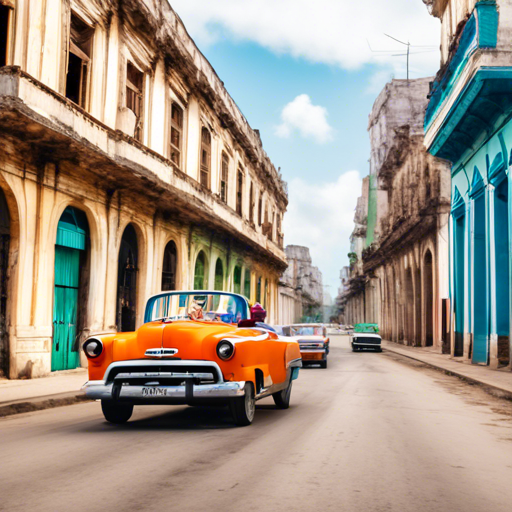a comprehensive guide to cuba's historical landmarks

A Comprehensive Guide to Cuba's Historical Landmarks
Welcome to our in-depth exploration of Cuba's most significant historical landmarks. This guide is designed for history enthusiasts, travelers, and anyone interested in the rich cultural tapestry of this Caribbean gem. We will delve into the stories behind these iconic sites, providing you with a detailed understanding of their historical significance and cultural impact.
Havana: The Heart of Cuban History
Havana, the capital city of Cuba, is a treasure trove of historical landmarks. Its vibrant streets are lined with colonial architecture, museums, and monuments that tell the story of Cuba's past.
Old Havana (Habana Vieja)
Old Havana, a UNESCO World Heritage site, is a must-visit for anyone interested in Cuban history. The area is characterized by its well-preserved colonial buildings and cobblestone streets.
- Plaza de la Catedral: This stunning square is home to the Havana Cathedral, a prime example of Cuban Baroque architecture.
- El Capitolio: Modeled after the U.S. Capitol, this building is a symbol of Cuba's political history.
- Castillo de la Real Fuerza: One of the oldest stone fortresses in the Americas, offering panoramic views of the harbor.
Walking through Old Havana is like stepping back in time. The blend of Spanish colonial architecture and vibrant street life creates a unique atmosphere that is both historical and lively.
El Malecón
El Malecón is a famous seawall and promenade that stretches for 8 kilometers along the coast of Havana. It is not just a place for a leisurely stroll but a historical landmark in its own right.
- Historical Significance: Built in the early 20th century, El Malecón has witnessed numerous historical events, including political rallies and social gatherings.
- Cultural Hub: The promenade is a popular spot for locals and tourists alike, offering a glimpse into everyday Cuban life.
El Malecón is a living museum where the past and present coexist, making it an essential stop for anyone visiting Havana.
Santiago de Cuba: The Cradle of the Revolution
Santiago de Cuba, the second-largest city in Cuba, is often referred to as the "Cradle of the Revolution." This city played a pivotal role in the Cuban Revolution and is home to several important historical landmarks.
Moncada Barracks
The Moncada Barracks is one of the most significant sites in Cuban revolutionary history. It was here that Fidel Castro led a failed attack on July 26, 1953, marking the beginning of the Cuban Revolution.
- Historical Museum: The barracks now house a museum that details the events of the attack and the broader history of the Cuban Revolution.
- Symbol of Resistance: The site serves as a powerful symbol of resistance and the struggle for Cuban independence.
Visiting the Moncada Barracks provides a deep insight into the revolutionary spirit that shaped modern Cuba.
San Pedro de la Roca Castle
San Pedro de la Roca Castle, another UNESCO World Heritage site, is a fortress that overlooks Santiago de Cuba's bay. Built in the 17th century, it is an excellent example of military architecture.
- Strategic Importance: The castle was constructed to protect the city from pirate attacks and foreign invasions.
- Architectural Marvel: Its design reflects the military engineering techniques of the time, making it a fascinating site for history and architecture enthusiasts.
The castle offers breathtaking views of the bay and a glimpse into the military history of Cuba.
Trinidad: A Colonial Gem
Trinidad, another UNESCO World Heritage site, is one of the best-preserved colonial towns in the Americas. Its cobblestone streets and colorful buildings make it a picturesque destination with a rich history.
Plaza Mayor
Plaza Mayor is the heart of Trinidad and a focal point for its historical landmarks. The square is surrounded by beautifully preserved colonial buildings and museums.
- Museo Romántico: Housed in a colonial mansion, this museum offers a glimpse into the opulent lifestyle of Trinidad's colonial elite.
- Iglesia Parroquial de la Santísima Trinidad: This church is one of the largest in Cuba and features a stunning neoclassical design.
Strolling through Plaza Mayor is like walking through a living museum, where every building tells a story of Trinidad's colonial past.
Valle de los Ingenios
The Valle de los Ingenios, or Valley of the Sugar Mills, is a short drive from Trinidad and is a testament to Cuba's sugar industry during the colonial period.
- Historical Significance: The valley was once home to over 50 sugar mills, which played a crucial role in Cuba's economy.
- Manaca Iznaga Tower: This tower offers panoramic views of the valley and was used to oversee the sugar plantations.
Visiting the Valle de los Ingenios provides a deeper understanding of the economic forces that shaped Cuba's history.
Conclusion
Cuba's historical landmarks offer a fascinating journey through the island's past. From the colonial architecture of Havana and Trinidad to the revolutionary sites in Santiago de Cuba, each landmark tells a unique story. Whether you are a history buff or a casual traveler, these sites provide a rich and immersive experience that will deepen your appreciation for Cuba's cultural heritage.
FAQ
| Question | Answer |
|---|---|
| What is the best time to visit Cuba? | The best time to visit Cuba is from November to April when the weather is dry and temperatures are pleasant. |
| Do I need a visa to visit Cuba? | Yes, most travelers need a visa to enter Cuba. It is advisable to check the specific requirements based on your nationality. |
| Is it safe to travel to Cuba? | Yes, Cuba is generally considered safe for tourists. However, it is always wise to take standard precautions and stay informed about local conditions. |
| What currency is used in Cuba? | Cuba uses the Cuban Peso (CUP) and the Cuban Convertible Peso (CUC). It is important to understand the difference between the two currencies. |
For more travel tips and information, visit this travel guide.
